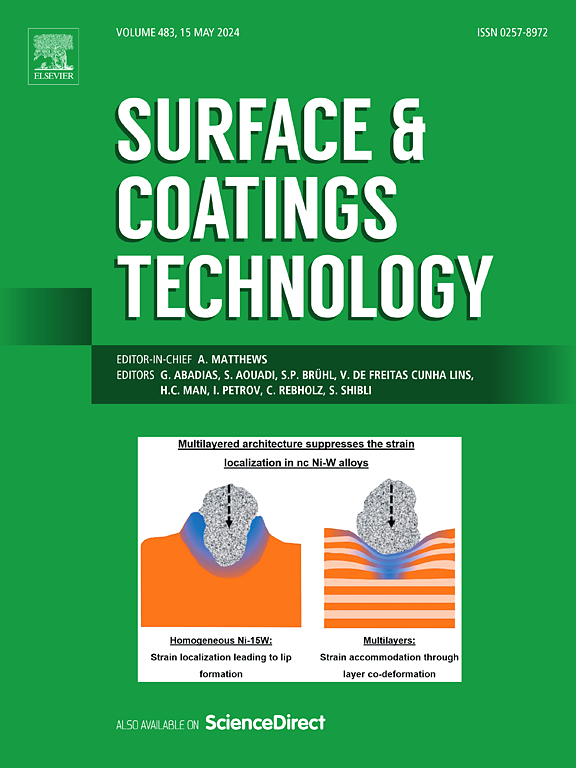Thermal shock resistance of TiAlCrY/rare-earth aluminate ceramics thermal barrier coatings on TiAl single crystals
IF 5.3
2区 材料科学
Q1 MATERIALS SCIENCE, COATINGS & FILMS
引用次数: 0
Abstract
TiAl single crystals have received much attention in aviation industry owing to their low density and excellent high-temperature properties. Yet, their poor oxidation resistance above 1000 °C limits their widespread applications. Rare-earth aluminate ceramics such as LaMgAl11O19 (LaMA) and Y3Al5O12 (YAG) are promising thermal barrier coating (TBC) candidates because of their high thermal stability and low oxygen permeability. In this study, LaMA and YAG powders were synthesized and deposited as top coats on TiAlCrY bond-coated TiAl substrates via APS. Their thermophysical properties and thermal shock resistance at 1100 °C were systematically explored. Results showed that both LaMA and YAG coatings exhibited superior oxygen barrier performance compared to conventional YSZ, mainly due to their lower oxygen vacancy concentrations. Besides, the LaMA/TiAlCrY TBC achieved a thermal shock lifetime of about 150 cycles, three times that of the YAG-based system, and comparable to YSZ/MCrAlY TBCs on Ni-based superalloys. The improved durability of the LaMA coating was attributed to better CTE compatibility, reduced amorphous phase crystallization, and lower elastic modulus, which together mitigated thermal stress-induced cracking. These results provide insights into the design of high-performance TBCs for TiAl-based components.
TiAl单晶TiAlCrY/稀土铝酸盐陶瓷热障涂层的抗热震性能
TiAl单晶以其低密度和优异的高温性能在航空工业中受到广泛关注。然而,它们在1000°C以上的抗氧化性差限制了它们的广泛应用。稀土铝酸盐陶瓷,如LaMgAl11O19 (LaMA)和Y3Al5O12 (YAG),由于其高热稳定性和低氧渗透率,是很有前途的热障涂层(TBC)候选材料。在这项研究中,合成了LaMA和YAG粉末,并通过APS将其作为面涂层沉积在TiAlCrY键合的TiAl衬底上。系统地研究了它们在1100℃时的热物理性能和抗热震性能。结果表明,与传统的YSZ涂层相比,LaMA和YAG涂层具有更好的氧屏障性能,这主要是由于它们具有更低的氧空位浓度。此外,LaMA/TiAlCrY TBC实现了约150次的热冲击寿命,是yag系统的三倍,与ni基高温合金的YSZ/MCrAlY TBC相当。LaMA涂层耐久性的提高是由于更好的CTE相容性,减少了非晶相结晶,降低了弹性模量,这些因素共同减轻了热应力引起的开裂。这些结果为基于tial的组件的高性能tbc设计提供了见解。
本文章由计算机程序翻译,如有差异,请以英文原文为准。
求助全文
约1分钟内获得全文
求助全文
来源期刊

Surface & Coatings Technology
工程技术-材料科学:膜
CiteScore
10.00
自引率
11.10%
发文量
921
审稿时长
19 days
期刊介绍:
Surface and Coatings Technology is an international archival journal publishing scientific papers on significant developments in surface and interface engineering to modify and improve the surface properties of materials for protection in demanding contact conditions or aggressive environments, or for enhanced functional performance. Contributions range from original scientific articles concerned with fundamental and applied aspects of research or direct applications of metallic, inorganic, organic and composite coatings, to invited reviews of current technology in specific areas. Papers submitted to this journal are expected to be in line with the following aspects in processes, and properties/performance:
A. Processes: Physical and chemical vapour deposition techniques, thermal and plasma spraying, surface modification by directed energy techniques such as ion, electron and laser beams, thermo-chemical treatment, wet chemical and electrochemical processes such as plating, sol-gel coating, anodization, plasma electrolytic oxidation, etc., but excluding painting.
B. Properties/performance: friction performance, wear resistance (e.g., abrasion, erosion, fretting, etc), corrosion and oxidation resistance, thermal protection, diffusion resistance, hydrophilicity/hydrophobicity, and properties relevant to smart materials behaviour and enhanced multifunctional performance for environmental, energy and medical applications, but excluding device aspects.
 求助内容:
求助内容: 应助结果提醒方式:
应助结果提醒方式:


